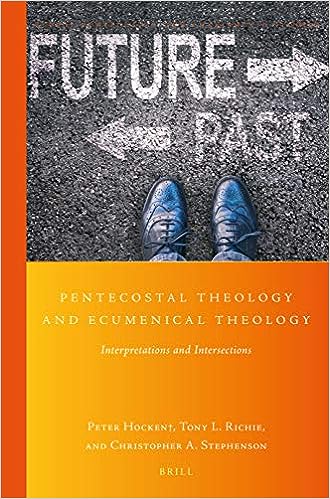Pentecostal Theology and Ecumenical Theology
 Peter Hocken, Tony L. Richie, and Christopher Stephenson, eds., Pentecostal Theology and Ecumenical Theology: Interpretations and Intersections, Global Pentecostal and Charismatic Studies Vol. 34 (Leiden; Boston: Brill, 2019), 368 pages, ISBN 9789004408364.
Peter Hocken, Tony L. Richie, and Christopher Stephenson, eds., Pentecostal Theology and Ecumenical Theology: Interpretations and Intersections, Global Pentecostal and Charismatic Studies Vol. 34 (Leiden; Boston: Brill, 2019), 368 pages, ISBN 9789004408364.
In volume thirty-four of Brill’s Global Pentecostal and Charismatic Studies, editors Peter Hocken, Tony L. Richie, and Christopher Stephenson spearhead a collection of essays discussing varied interpretations and intersections of Pentecostal theology and Ecumenical theology. The editors and authors of the volume come from varied streams in the global Pentecostal/Charismatic movement and represent a collective of like-minded scholars, who’ve not only contributed to Pentecostal/Charismatic theology, but also supported ecumenical dialogues. Peter Hocken, who died before the final release of said volume, was himself an accomplished ecumenist and a Catholic Charismatic (ix).
Cecil M. Robeck has chronicled that early Pentecostal responses to ecumenism were of trepidation and misconception.
In an introductory chapter, Christopher Stephenson explained that the two theologies share commonalities: both proliferated in the 20th century, and both claim its origination from the Holy Spirit’s renewal of the Church (xii). Hence, the editors explored the relationship between global Pentecostalism and the Ecumenical movement, assuming significant intersections that warrant organic and multidimensional studies. The result of their endeavors is a multi-authored volume of eighteen essays, unitedly expressing the massive potential of Pentecostal theology and Ecumenical theology when in organic communication with each other.
In part I, essays were largely descriptive of historical and current Pentecostal interpretations on ecumenism. Notable among the essays is one from Pentecostal historian and ecumenist, Cecil M. Robeck, who chronicled early Pentecostal ideation and response to ecumenism. Robeck pointed out that early responses were of trepidation and misconception—the idea of ecumenism being correlated to the coming of the Antichrist (4). It was only in later years after efforts made by Pentecostal ecumenists like David du Plessis that Pentecostals opened to the viability of ecumenism and ecumenical theology (27).
Cheryl Bridges Johns challenges Pentecostals to envision a future where they have played a key role in the quest for Christian unity.
In his essay, Swiss Pentecostal and ecumenist, Jean-Daniel Plüss identified key individuals in the modification of Pentecostal response to ecumenism which included not just du Plessis but also Leonhard Steiner, Donald Gee, Thomas Roberts, Walter Hollenweger and Jerry Sandridge (27-38). North American Holiness Pentecostal and ecumenist, Cheryl Bridges Johns, ends part I with a challenge to envision a future where Pentecostals played a key role in the quest for Christian unity and the interlocking of global Christianity (150). She challenges Pentecostals to a death and re-birth, as well as to a shifting of foci (150-151). Perhaps, when Pentecostals have gained fuller understanding of their identities, roles, and calling in God’s global agenda, they can contribute more to the pursuit of Christian unity (151).
Let’s explore the intersections between Pentecostal theological perspectives and ecumenical theologies.
In Part II of the book, a collection of essays directly related to intersections between Pentecostal theological perspectives and ecumenical theologies are explored. Frank D. Macchia’s contribution to the volume extrapolates Spirit baptism in ecumenical perspective. Macchia points out that Pentecostals have yet to fully appreciate the connection between Jesus’ impartation of the Holy Spirit (John 20:22; Acts 1:5-8; 2:4-33) and the ecumenical dimensions of such impartation. Macchia identifies the gift of the Spirit as “a gift that overflows boundaries and sweeps all peoples from every life context into its renewing power (Acts 2:17-33) …this is the expansive and eschatological dimension of Spirit baptism as a triune act of divine self-impartation and transformation of creation” (222). If seen in its expansive and eschatological dimension, Pentecostalism’s theology of Spirit baptism may provide significant bases for the ecumenical work of the Holy Spirit in the world today.
Asian Pentecostal, Simon Chan, adds his position to this discussion by proposing that the Holy Spirit’s coming at Pentecost (with the manifestation of tongues speech) inaugurates the Church as a “unity-in-diversity” (273). As a unity-in-diversity, the Pentecostal church can become an avenue for a confluence of traditions. Pentecostals can do this is by developing a more holistic charismatic worship in confluence with sacramental forms of Christianity (280). This confluence allows for the mutual engagement of both Pentecostal/Charismatic worship with liturgical/sacramental forms of Christianity.
Tony Richie calls Pentecostals to look to a future where Christianity is renewed and empowered by the Spirit, not in a homogenous manner, but in a unity-in-diversity.
Part two ends with a short essay from Tony L. Richie, who concludes the volume with a recognition that Pentecostal experience (with tongues-speech) can be considered as a “theological resource replete with ecumenical significance” (359). Pentecostals are called to look to a future where Christianity is renewed and empowered by the Spirit, not in a homogeneous manner, but in a unity-in-diversity. This divine vision creates a catholic (universal) church reflective of God’s kingdom on earth. This vision can only actualize if Pentecostals and Christian ecumenists all over the world recognize that both theologies have something to contribute to each the other, and that both are stronger together than apart.
I highly recommend this volume, Pentecostal Theology and Ecumenical Theology. The editors did a great job of collecting essays that not only inform readers of both theologies’ historical and current interpretations but also of the potential richness in their intersections. Each contributing author brings convincing propositions and evokes further reflection. It may also serve as a prolepsis to the future of Pentecostal/Charismatic scholarship.
Reviewed by Lora Angeline E. Timenia
Publisher’s page: https://brill.com/display/title/39536








Leave a Reply